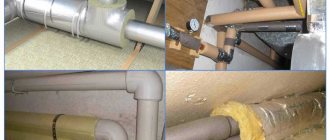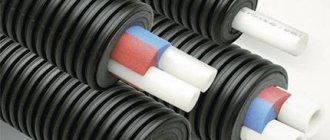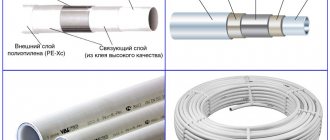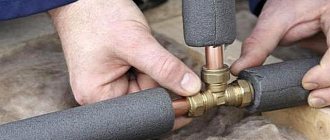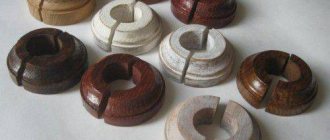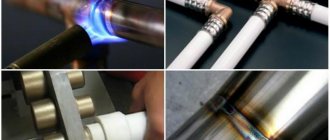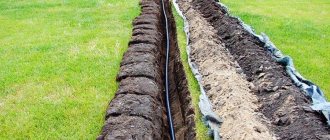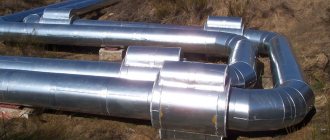Pipelines for various purposes need protection from freezing or heat loss. Insulating pipes with mineral wool copes better with these tasks than others. This method of thermal insulation has been used for many decades, during which it has proven its high efficiency. Currently, insulation of pipelines with mineral wool is carried out using several types of thermal insulation materials, such as:
- roll insulation made of basalt and silicate mineral wool;
- flexible mats;
- insulating cylinders, bends, tees for heating systems, hot and cold water supply, air ducts, chimneys, etc.
In turn, mineral wool for pipes and products made from it are divided into materials for insulating utility networks indoors, as well as for pipelines laid in channels, trenches and in the open air. They are distinguished by the presence or absence of additional protection from external influences.
For which pipelines is mineral wool used?
Mineral wool can be used in combination with other insulation materials.
Thermal insulation of pipelines with mineral wool is a set of measures aimed at reducing heat transfer in the following communication systems:
- heating;
- hot water supply;
- water pipes;
- sewerage;
- conditioning.
Mineral wool for insulating pipelines works on the principle of a thermos, when hot remains hot and cold remains cold. In addition to preventing heat transfer, the insulating material transfers the dew point, so condensation does not form on the pipes. Also, all types of mineral wool have high sound-proofing and vibration-absorbing characteristics. This aspect is extremely important when insulating the air ducts of air conditioning and air heating systems in houses.
Mineral wool insulation for pipes is used inside unheated rooms, for underground and above-ground installation of communications. In the last two cases, especially careful insulation is required, since heat loss due to wind, snow, and moisture in the ground increases greatly, especially in cold climate zones.
Probably the smallest heaters for the home are fan heaters with ceramic heating elements.
Read more about modern heaters for summer cottages in this article.
How to place an order
If you need mineral wool for pipelines, insulation for walls, roofs, facades or other types of thermal insulation materials, we recommend signing up for a free consultation here on the website. Our specialists will help you choose the thermal insulation that is best suited to solve the problems you face.
With them you will resolve issues of order delivery in Moscow and the region. We remind you that for large wholesalers and regular partners of our company we offer products at the lowest prices. These categories of customers can buy any products from our catalog on especially favorable terms.
What materials are used for pipe insulation?
Shells with foil for pipe insulation.
Mineral wool is the general name for all fibrous thermal insulation materials, for the production of which various types of minerals are used. In civil engineering, only two types of mineral wool are used for pipes:
- glass wool;
- basalt wool.
Glass wool is made from quartz or its derivative (glass). The fibers of this material are long and soft, they do not break, so a material of any configuration is suitable for insulating pipes with fiberglass mineral wool. Glass wool is produced in slabs, mats, rolls and cylinders. If you do not take into account the cylinders (shells), then the differences lie only in the length of the material. The slabs are the shortest, the mats are twice as long, and the rolls are the longest. The size depends on the manufacturer, there is no general standard. Thickness from 50 to 150 mm. Each of the products can be laminated with foil.
There is a pattern: as the density of a thermal insulation material increases, its thermal conductivity also increases, that is, it works worse as insulation.
Mineral wool for insulating pipes in cylinders consists of two parts - this is a sleeve, the internal cross-section of which is equal to the outer diameter of the communications. The nominal diameter of the shells varies from 18 to 1024 mm. Insulation thickness is from 20 to 80 mm, standard length is 1 m. They can also be covered on the outside with foil. General characteristics for all fiberglass insulation:
- thermal conductivity lambda 0.036-0.042 W/m*k;
- high hygroscopicity;
- flammability class NG.
Fiberglass mineral wool for pipelines is much lighter than basalt insulation, and accordingly, its density is also lower. Basalt wool for pipes is produced only in shells and lamella rolls - these are many narrow rectangles (lamellas) glued to a base. Basalt is a volcanic rock, essentially a stone, hence the name of the material. Stone wool is very dense, its fibers are short and inelastic. They break and this creates dust. A priori, it will not be possible to wrap communications with a regular basalt slab; it will simply break.
Keep in mind that a home air heater can burn oxygen. Pay attention to the configuration of the heating element.
Here we describe the principle of operation of a fireplace with a water circuit, which is capable of heating a medium-sized house.
Advantages of using mineral wool cylinders
A thermal insulation cord made of mineral wool or a full-fledged cylinder made of a unique material is the best option for insulating pipelines of various types.
Using this particular form of heat insulator has a lot of advantages and disadvantages, among which are:
- Low level of thermal conductivity. Inside the layer of the mineral wool cylinder there is a large volume of air, which (thanks to the thin and flexible fibers of the material) remains motionless and does not allow heat to pass through;
- Resistant to fire and high temperatures. The instructions for mineral wool cylinders indicate that they are non-flammable, do not melt and do not lose their shape even when exposed to extremely high temperatures (from -150C to +750C);
- Long term trouble-free operation. The use of basalt rocks and slag as raw materials extends the service life of mineral wool-based insulation by almost decades. On average, even the most inexpensive heat insulator can last 50-60 years without losing its performance qualities;
Variety of shapes and sizes of insulation materials
- Durability and reliability. Mineral wool easily withstands even the highest loads and pressure. Cotton wool has closely interwoven fibers, and therefore its density and strength are significantly increased;
- Hydrophobicity. The insulation has increased resistance to moisture thanks to protective layers of foil and fiberglass, due to this it is not afraid of direct contact with water. If necessary, the materials can be additionally treated with special water-repellent compounds;
Advice. If the pipeline is to be used in conditions of high humidity, then it is best to subject the mineral wool to additional processing. Thus, it will be possible to extend the life of the highway and significantly reduce the cost of maintenance and repairs.
- Availability. The price of mineral wool heat insulators is in an affordable range, which allows them to be used for insulation of even long pipelines;
- Ease of use. Anyone can insulate even large volumes of pipelines with their own hands. The thermal insulation process is quite simple, requiring the use of only available materials;
Half-cylinders made of mineral wool
- Environmental friendliness. Cylinders and semi-cylinders made from natural raw materials are absolutely safe for human health and the environment. As a result, mineral wool materials can be used to insulate any pipes.
Efficiency and benefits of using mineral wool insulation for pipes
Thermal insulation materials made of mineral wool, made in the form of cylinders, make it possible to achieve high efficiency and provide the best operating conditions for highways:
- Heat losses in straight sections of pipelines when using mineral wool will be reduced by almost 3.6 times. Unlike other materials, it loses only 8% of heat, which is very important, especially for hot water supply systems;
- Reducing the time spent on thermal insulation. There is no longer any need to wrap pipes with fiberglass and mineral wool mats - the cylinders have an internal diameter similar to the dimensions of the main line;
Simple cutting of material with a knife during installation
- Protective coatings will help prevent damage to the cylinders from the insulation and maintain the level of thermal insulation for a long time. At the same time, the thickness of the insulating layer is not lost throughout the entire service life.
Advice. To simplify the process of covering pipes with mineral wool insulation in the form of cylinders and half-cylinders, the use of a construction knife will help. Cutting materials with such a tool is much easier, and dimensional accuracy can be maintained.
Thermal insulation materials made on the basis of mineral wool in the shape of cylinders are an excellent option for pipes of any type, size and length.
It should be noted that the domestic market is filled with offers from various manufacturers; you can choose the right type of insulation specifically for a specific pipeline with a certain diameter, length and types of transported material.
The use of special coatings for additional protection of thermal insulation materials from the negative effects of mechanical damage and other factors
Pipeline insulation method
This state of affairs leads to colossal heat losses.
Thermal insulation of pipes with mineral wool is carried out taking into account the high hygroscopicity of the material, that is, the ability of the insulation to absorb and retain moisture. At the same time, when the insulator gets wet, it loses its qualities, and instead of insulation, on the contrary, it accelerates heat loss. Therefore, you need to use waterproofing. Roofing felt or foil is often used for this purpose.
The foil on the thermal insulation itself also saves the material from moisture, but the ends remain unprotected, through which water can easily penetrate inside. The installation method for roll insulation is extremely simple:
- communications are wrapped in mineral wool for pipelines so that each subsequent turn overlaps the previous one by 5 cm;
- the insulation is fixed with wire;
- Using the same principle, the waterproofing is screwed on and clamped with stainless wire.
If the insulation of pipelines with mineral wool is carried out with foil materials, then the reflective surface is placed outside. Installing the cylinders is even easier. You just need to put the shell on the pipe like a cover. A special glue is applied to the longitudinal section of the heat-insulating cylinder, which is protected with paper tape. The tape is removed during installation.
When laying communications underground, any thermal insulation must be protected from mechanical influences, because the weight of the earth is considerable. Therefore, the pipes along with thermal insulation are placed in plastic sleeves. Large diameter PVC sewer pipes are suitable. There are also special insulated pipes on sale, covered with a polymer layer.
Calculation of the thickness of the thermal insulation layer
The choice of insulation should take into account the thickness of the thermal insulation layer. This value is calculated based on current standards.
Heat losses in an insulated pipeline should not exceed the values regulated by SNiP. To simplify the calculations, the resistance of the walls of metal pipes to heat conduction is not taken into account (it is extremely low), as well as heat loss when heating the walls of pipes protected by thermal insulation.
Additional files with tables for calculation can be obtained from the link [293.59 Kb] (downloads: 25).
Results
Mineral wool for pipeline insulation comes in two types: glass wool and stone (basalt) wool. Any glass wool can be used (plates, mats, rolls, with or without foil). It is soft and elastic, you can wrap it around communications without any problems. Stone wool is inelastic, so only lamella mats can be used. There are also thermal insulation cylinders made of mineral wool - these are sleeves, the nominal diameter of which must be equal to the outer diameter of the pipe. Cylinders come in different diameters, thicknesses, with or without foil.
Conclusion
Mineral wool is an insulation with unique characteristics, the best option if it is necessary to protect pipelines of various categories from the negative effects of temperature changes, the negative effects of various factors, ranging from chemicals to mechanical damage.
Due to their convenient form and affordable cost, you can choose the most optimal heat insulators for each specific case, ensuring a wide range of work is completed without wasting time and money.
In the video presented in this article you will find additional information on this topic. The process itself is very simple, accessible to every person, even those not prepared for construction work.
Video description
The following video shows how mineral wool cylinders are mounted on a pipeline:
Insulation made of polystyrene foam and polystyrene foam
Insulating pipes with foam plastic is the simplest and most inexpensive way to insulate them. This material has all the necessary properties: it does not burn, withstands stress well, does not emit toxic substances, almost does not absorb water, is very easy to install and can be used repeatedly. Its only drawback is its attractiveness to mice and other rodents. Which, however, is unimportant when insulating underground pipelines, for which it is most often used.
Extruded polystyrene foam has even better technical characteristics - it is denser and more moisture-resistant, and better resists the destructive effects of ultraviolet rays.
Both materials are produced in the form of so-called shells - sections that are halves of a cylinder with a tongue-and-groove connection. They can be covered with a protective foil shell. This design allows the insulation to be used repeatedly, removing it for inspection or repair of communications.
“Shell” for insulating foam pipes Source standartt.ru
The high density and compressive strength that such thermal insulation of pipelines has allows it to be used both for external pipes and for underground pipelines without installing rigid trays. For various nodes and turns, corresponding shaped shells are produced.
To lay several pipes or large-diameter pipes, special multi-profile segments or slabs of polystyrene foam or expanded polystyrene can be used, from which strips are cut and the box is assembled. Its walls are fastened with polyurethane foam.
Warm polystyrene box Source i.ytimg.com
For reference! Foam glass has similar properties and characteristics, characterized by absolute waterproofness, non-flammability, inertness to chemicals, but also a high price. The form of production of pipe insulation from this material is shells, segments, shaped parts.
Polyurethane foam insulation
Polyurethane foam is one of the most modern insulation materials, which is a cellular polymer material whose closed cavities are filled with carbon dioxide. It makes very effective thermal insulation for heating and water supply pipes.
On sale you can find pipes already insulated with polyurethane foam and covered with a protective sheath: polyethylene for underground installation and galvanized steel for surface installation.
Source https://ks-teplo.ru/assets/images/%D0%9F%D0%9F%D0%A3.jpg
High pressure thermal insulation
As a method of insulating a pipeline in a private house or country house, one can consider creating and maintaining high pressure in it. How it's done:
- to embed a receiver into the finished pipeline , which will have to create the necessary pressure - 3-5 atmospheres is quite enough;
- It is also necessary to additionally use submersible pump, to create pressure from 5 to 7 atm.;
- After the pump, a check valve and a tap are installed in front of the receiver;
- To start the system, you need to close the tap in front of the receiver and turn on the pump;
- The resulting pressure must be maintained in the system continuously until it is in use;
- To allow the pipeline to function again, you simply need to bleed off the excess air.
